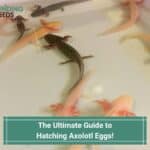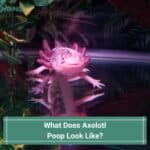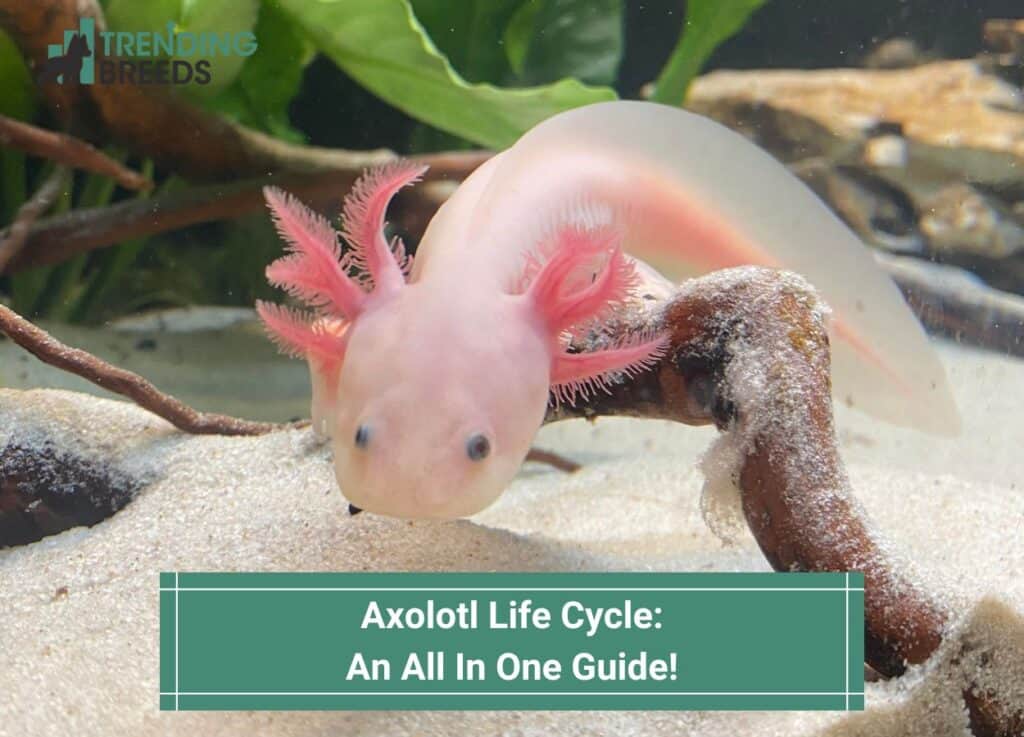
Comprehending the Axototl life cycle is significant for scientific research and conserving and safeguarding this endangered species.
Whether you are a researcher, a student, or simply an individual interested in Axolotls, here is a complete guide on the Axolotl life cycle.
The Axolotl, a charming aquatic creature sometimes called the Mexican salamander, possesses beauty and uniqueness.
Renowned for their ability to regenerate lost body parts, these amphibians have captivated the interest of many.
Axolotls exclusively inhabit the freshwater lakes of Mexico City and have served as subjects of scientific inquiry for numerous years, primarily due to their remarkable regenerative capabilities.
Moreover, their distinctive life cycle adds to their allure.
Let’s delve into the various stages that span from egg to adulthood.
Before you scroll further down this guide, check out these other animal-related articles: Axolotl Shedding: What To Do And Why and A Guide to Hunting Squirrels With Dogs: Easy and Fun.
Table of Contents
Birth and Lifecycle

Known as the “Walking fish,” Axolotls are amazing amphibians from Mexico.
Once considered a dietary staple by the Aztecs, they have gained popularity as captivating pets for aquariums and tanks.
The life cycle of Axolotls commences when a female lays her eggs, which the male fertilizes.
These eggs are typically grouped and attached to aquatic plants or rocks. Within approximately 10 to 14 days, the fertilized eggs hatch into larvae.
These larvae sustain themselves by consuming tiny marine organisms and undergoing rapid growth.
After six to 12 months, they embark on the transformative journey of metamorphosis.
During this process, Axolotls undergo various physical changes as their lungs develop and they lose their gills.
Upon metamorphosing, Axolotls attain adulthood, becoming capable of reproduction. Nonetheless, what truly captures the attention of Axolotls is their remarkable ability to retain their larval characteristics throughout their adult lives.
Consequently, these amphibians only partially transition into a terrestrial form. Axolotls exclusively inhabit aquatic environments, both in the wild and in captivity.
They possess the extraordinary capacity to regenerate lost body parts, including portions of their brain, limbs, spinal cords, and more.
While Axolotls are captivating creatures, they face the critical threat of being endangered.
Loss of natural habitats, pollution, and excessive collection for the pet trade have contributed to their declining numbers.
Conservation initiatives are actively underway to safeguard Axolotl populations and ensure their survival for future generations.
How Do Axolotls Turn Into Salamanders? Axolotl Salamander Life Cycle

Axolotls have the potential to undergo metamorphosis and transform into salamanders, assuming a terrestrial form.
However, it’s important to note that metamorphosis is not a natural part of the Axolotls’ life cycle.
Instead, these amphibians can undergo metamorphosis through various factors, including hormonal treatments and environmental cues such as temperature, light, and water quality changes.
During metamorphosis, Axolotls experience a series of physical changes that enable them to adapt to a terrestrial lifestyle.
These changes involve the resorption of their gills, the development of lungs for breathing air, the strengthening of their skeletal structure to support their body weight on land, and the growth of more robust limbs.
However, it is crucial to understand that not all Axolotls will naturally undergo metamorphosis, even under favorable conditions.
The process is more complex than it may initially appear.
Most Axolotls will remain in their larval form throughout their lives, retaining their gills and other larval features.
Moreover, inducing metamorphosis in Axolotls is a delicate process that requires careful consideration.
Factors such as unsuitable environmental conditions or imbalanced hormonal treatments during this process can lead to deformities or, in some cases, prove fatal.
It is essential to emphasize that only experienced veterinarians or biologists should attempt to induce metamorphosis in Axolotls.
Understanding the complexities and risks involved in the metamorphosis of Axolotls is vital for their well-being and should be approached with caution and expertise.
Lifespan in Captivity
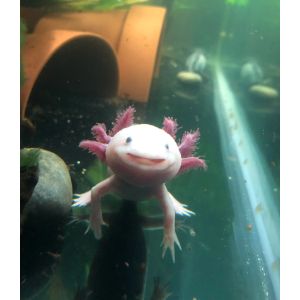
Axolotls have a comparatively long lifespan in captivity compared to other aquatic amphibians.
On average, they live for 10 to 12 years, but some individuals can exceed 15 years or even more with proper care.
Several factors influence the lifespan of an Axolotl, including overall health, diet, and water quality.
Axolotls require a well-maintained aquatic environment to promote a long and healthy life.
Clean and fresh water and a balanced diet of various protein-rich foods are crucial for their well-being.
It’s important to note that Axolotls can be prone to various health issues.
Bacterial and fungal infections, parasites, and stress-related illnesses are common.
However, regular health check-ups and prompt treatment can help ensure these fascinating creatures’ healthy and extended lifespans.
Axolotl Lifespan in the Wild
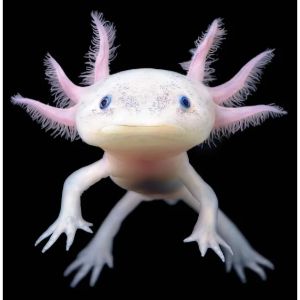
In the wild, the precise lifespan of Axolotls is not extensively known.
However, experts believe their lifespan is considerably shorter than their captive counterparts.
Axolotls in their natural habitat face numerous threats that can impact their longevity. Predation, habitat loss, pollution, and diseases are challenges they encounter.
Wild Axolotls also experience seasonal environmental variations, which can influence their lifespan.
Factors such as fluctuations in temperature and water levels can have an impact on their survival.
Additionally, Axolotls must compete with other aquatic species for food and resources in their natural habitat, further affecting their lifespan.
Despite their challenges in the wild, Axolotls have adapted to their unique lifestyle.
Their ability to regenerate lost body parts and specialized features enable them to thrive in their natural environment.
However, ongoing conservation efforts are crucial for preserving their habitats and ensuring the long-term survival of this remarkable species.
How Many Stages Of Life Do Axolotls Have?
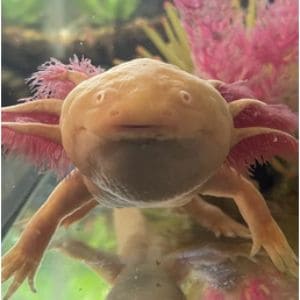
Axolotls progress through four primary life stages: Egg, Larva, Juvenile, and Adult.
The Egg Stage
The first stage, the Egg stage, involves developing and hatching fertilized axolotl eggs.
The eggs are immersed in water and undergo embryonic development until they hatch into larvae.
The Larva Stage
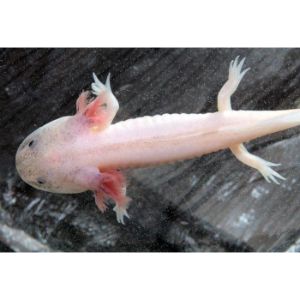
The Larva stage is the most prolonged and most distinct phase in the life cycle of an Axolotl.
The larvae are fully aquatic and possess external gills, which they use for breathing underwater.
This stage can last several months to several years, during which the larvae undergo multiple growth stages.
They periodically shed their skin as they develop and grow.
The Juvenile Stage
As the larvae continue to mature, they transition into the Juvenile stage.
In this stage, the young axolotls develop more adult-like characteristics, including larger limbs and a more prominent head.
They also begin the development of their reproductive organs during this phase.
The Adult Stage
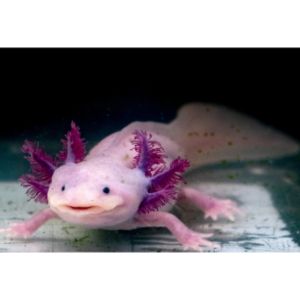
Finally, the Axolotls reach the Adult stage as they mature. In this stage, they achieve their full size and sexual maturity.
Adult axolotls can breed and produce offspring, contributing to the continuation of their species.
These distinct life stages, from Egg to Larva, then to Juvenile, and finally to Adult, encompass the fascinating life cycle of Axolotls.
How Long Until an Axolotl is Fully Grown?
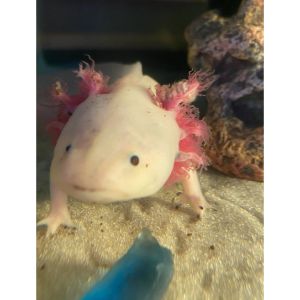
It typically takes approximately 18 to 24 months for an axolotl to reach its full size, although this timeline can vary depending on factors such as genetics, diet, and environmental conditions.
During this growth phase, axolotls can reach 9 to 12 inches.
However, it’s important to note that some axolotls may continue to grow beyond this timeframe, mainly if provided with an optimal environment and a high-quality diet.
Interestingly, even after reaching sexual maturity, some axolotls grow for several years.
Their neotenic nature allows them to retain their larval features, setting them apart from fully-grown amphibians.
As a result, axolotls may have a distinct appearance throughout their lives.
It is crucial to provide axolotls with a suitable habitat that includes clean and fresh water, a varied and nutritious diet, and regular veterinary check-ups to ensure healthy growth and longevity.
By meeting their specific care requirements, axolotls can reach their maximum potential size and enjoy a fulfilling and extended lifespan.
Amazing Axolotl Life Cycle Facts
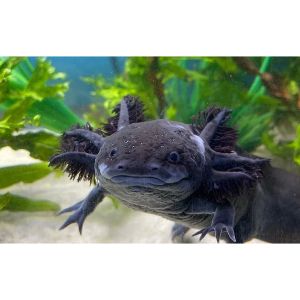
Here are some interesting and important facts about the axolotl life cycle:
- Axolotls are neotenic, meaning they retain their larval features even as adults, distinguishing them from other amphibians.
- The larval stage of the axolotl life cycle can last several years, during which the larvae undergo multiple growth stages.
- Axolotls have the remarkable ability to regenerate lost body parts, including limbs, spinal cords, and even parts of their brain, making them a valuable research model.
- Metamorphosis in axolotls is not a natural part of their life cycle and happens under specific environmental or hormonal conditions.
- In the wild, axolotls face habitat loss, pollution, disease, and predation threats, making them critically endangered and subject to international conservation laws.
- With proper care, axolotls can live up to 15 years or more in captivity, requiring a long-term commitment from their keepers.
- Axolotls can breathe through their skin, in addition to their external gills, which makes them vulnerable to environmental toxins and pollutants.
- Cannibalistic behavior has been observed in wild axolotls, especially when food is scarce, although it is more common in the larval stage.
- Axolotls possess the unique ability to regenerate their spinal cords, a rare quality in the animal kingdom that has implications for human spinal cord injury research.
- Axolotls are considered a delicacy in Mexico, although their critically endangered status calls for conservation efforts.
- Axolotls are also known as water monsters or Mexican walking fish, though they are not fish but amphibians.
- Axolotls have a highly developed sense of smell, which they use to detect prey and navigate their environment. Their olfactory organs are sensitive to small concentrations of chemicals in the water, highlighting the importance of using non-chlorinated freshwater when keeping them as pets.
- Axolotls can close their eyes to protect them while still being able to see through their eyelids, allowing them to remain alert and protected.
FAQs About Axolotl Life Cycle

How long do axolotls live?
Axolotls have a relatively long lifespan compared to many other aquatic amphibians.
In captivity, the average lifespan of an axolotl is around 10 to 12 years. Some individuals can live up to 15 years or even longer with proper care.
However, it’s important to note that axolotls’ lifespan can depend on various factors such as genetics, diet, water quality, and overall health.
Providing a suitable environment, balanced nutrition, and regular veterinary check-ups can help ensure a healthy and long life for your Axolotl.
How do axolotls turn into salamanders?
Axolotls can undergo metamorphosis and transform into salamanders, a terrestrial form.
However, it’s important to note that metamorphosis is not a natural part of the axolotl life cycle and does not occur in all individuals.
Metamorphosis in axolotls can happen under specific conditions, such as changes in hormonal treatments or environmental cues like temperature, light, and water quality.
By manipulating these factors, researchers or experienced individuals can prompt axolotls to undergo metamorphosis.
During metamorphosis, axolotls go through a series of physical changes. Their gills start to resorb, and their lungs develop to allow them to breathe air.
Their limbs become more robust to support their weight on land and undergo other structural and physiological modifications necessary for terrestrial life.
It’s important to note that not all axolotls will naturally or easily undergo metamorphosis, and attempting to induce it requires expertise and careful consideration.
Factors like inappropriate environmental conditions or hormonal treatments during transition can lead to deformities or even be fatal for the Axolotl.
Therefore, it is best that only experienced professionals, such as veterinarians or biologists, attempt to induce metamorphosis in axolotls, and you should only do it with proper knowledge and consideration.
How many babies does an axolotl have at a time?
Axolotls are capable of producing a large number of eggs during each breeding event.
A female axolotl can lay anywhere from a few hundred to over a thousand eggs at a time.
The exact number of eggs can vary based on factors such as the size and maturity of the female.
After the female Axolotl lays her eggs, the male fertilizes them externally.
The eggs are typically applied in clusters and are often attached to aquatic plants or rocks. Axolotls are known for their diligent care of their eggs.
They will often wrap their bodies around the egg clusters to provide protection and ensure adequate oxygenation.
It’s worth noting that while axolotls can produce many eggs, not all of them will successfully hatch and reach adulthood.
Water quality, temperature, and parental care can affect the eggs’ survival rate and the larvae’s subsequent development.
How long does it take an axolotl to mature?
The time it takes for an axolotl to mature can vary depending on various factors, including genetics, environmental conditions, and overall health.
An axolotl takes about 18 to 24 months to reach its full size and sexual maturity.
During this period, axolotls go through different developmental stages. They start as eggs, hatch into larvae, and gradually progress into juveniles.
Their limbs and other features develop as they grow and undergo physical changes that prepare them for adulthood.
It’s important to note that axolotls are neotenic, meaning they retain their larval features even as adults.
Unlike other amphibians, they do not undergo a natural metamorphosis into a terrestrial form.
Instead, they reach sexual maturity while maintaining their larval characteristics, such as external gills.
It’s also worth mentioning that some axolotls may continue to grow even after reaching sexual maturity, mainly if they have access to optimal environmental conditions and a high-quality diet.
Providing a suitable habitat with clean water, a balanced diet, and proper care can help axolotls reach their full potential size and lead a healthy and long life.
Are axolotls good pets?
Axolotls can make fascinating and unique pets for the right individuals. Here are some factors to consider when determining if an axolotl is a suitable pet for you:
Low-maintenance
Axolotls are generally considered low-maintenance pets compared to other animals.
They don’t require daily walks or social interaction like dogs or cats. However, they have specific care needs that you should meet to ensure their well-being.
Aquatic habitat
Axolotls are fully marine creatures requiring an appropriate tank setup with clean, filtered water and suitable hiding places.
Setting up and maintaining their aquatic environment can be crucial to their care.
Feeding requirements
Axolotls are carnivorous and require a diet primarily consisting of live or frozen protein-rich foods, such as bloodworms, brine shrimp, or small fish.
Providing a varied and balanced diet is essential for their nutritional needs.
Temperature and water quality
Axolotls are sensitive to temperature and water quality changes.
They thrive in cooler water temperatures (around 60-68°F or 15-20°C) and require proper filtration and regular water parameter monitoring.
Long lifespan
Axolotls have a relatively long lifespan compared to other aquatic animals.
They can live for 10 to 15 years or even longer with proper care. Owning an axolotl is a long-term commitment.
Limited handling
Axolotls have delicate skin and are not well-suited for frequent handling. They are best observed and appreciated in their aquatic habitat rather than when hand-held.
Researching and understanding axolotls’ specific care requirements before deciding to keep them as pets are essential.
Ensure you are willing to provide the necessary time, effort, and resources to create a suitable habitat and meet their needs throughout their lifespan.
Consulting with experienced axolotl owners or herpetologists can also provide valuable guidance.
Axolotl Life Cycle: An All In One Guide

Axolotls are captivating creatures that offer a unique and intriguing pet-keeping experience.
Their neotenic characteristics, remarkable regenerative abilities, and long lifespan make them stand out among other amphibians.
However, owning an axolotl requires careful consideration and commitment to providing the specific care they need.
Axolotls thrive in a well-maintained aquatic environment with clean water, appropriate temperature, and suitable hiding places.
Their carnivorous diet should consist of protein-rich foods to ensure proper nutrition.
While they may not be ideal for frequent handling, observing their behavior and appreciating their distinct features in their aquatic habitat can be highly rewarding.
Educating yourself about axolotl care requirements and seeking advice from experienced axolotl owners or herpetologists before bringing one into your home is crucial.
By understanding and meeting their unique needs, axolotls can thrive and provide joy and fascination for their owners.
These incredible creatures serve as a reminder of the diverse and wondrous world of aquatic life, and their conservation is essential to ensure their survival for future generations to appreciate and admire.
If you find this guide, “Axolotl Life Cycle: An All In One Guide,” informative and helpful, you can check out these other animal-related articles from our team:
- How to Get a Cat Out of Heat with a Q Tip? Step By Step Guide
- Cane Corso Bandogge Mix Guide
- Hibiscrub for Dogs: Complete Guide for Safe & Effective Use
You can learn more about axolotls by watching “The Insane Biology of: The Axolotl” down below:


